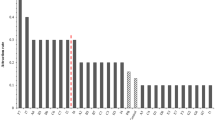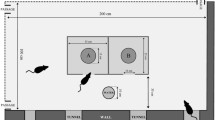Abstract
At least some anthranilates (e.g., methyl anthranilate), and acetophenones (e.g., orthoaminoacetophenone) are aversive to mice as well as to birds. Here we systematically examined nine acetophenone isomers (ortho, meta, para) and moieties (amino, hydroxy, methoxy) previously tested as drinking and feeding repellents for European starlings (Sturnus vulgaris). All nine substances reduced intake by mice in single-bottle tests. When molecular characteristics were examined, amino group reactivity and, to a lesser extent, isomeric position (i.e., resonance), were related to the strength of the avoidance response. Unlike effective avian repellents, the presence of intramolecular hydrogen bonds did not appear to affect avoidance responding.
Similar content being viewed by others
References
Beauchamp, G.K., andMason, J.R. 1991. Comparative hedonics of taste, pp. 159–183,in R.C. Bolles (ed.). The Hedonics of Taste. Lawrence Erlbaum Assoc, Hillsdale, New Jersey.
Clark, L., andShah, P.S. 1991. Nonlethal bird repellents: In search of a general model relating repellency and chemical structure.J. Wildl. Manage. 55:538–545.
Clark, L., Shah, P.S., andMason, J.R. 1991. Chemical repellency in birds: Relationship between chemical structure and avoidance response.J. Exp. Zool. 260:310–322.
Games, P.A. 1979. Assessment and statistical control of subject variables in longitudinal designs, pp. 179–198,in J.R. Nesselroade and P.B. Baltes (eds.). Longitudinal Research in the Study of Behavior and Development. Academic Press, New York.
Mason, J.R., Clark, L., andShah, P.S. 1991. Orthoaminoacetophenone repellency to birds: similarities to methyl anthranilate.J. Wildl. Manage. 55:334–340.
Mason, J.R.,Clark, L., andMiller, T.P. 1993. Evaluation of a pelleted bait containing methyl anthranilate as a bird repellent.Pestic. Sci. In press.
Meehan, A.P. 1988. Chemical repellents, pp. 399–406,in I.E. Prakesh (ed.). Rodent Pest Management. CRC Press, Boca Raton, Florida.
Nolte, D.L., Mason, J.R., andClark, L. 1993. Avoidance of bird repellents by mice (Mus musculus).J. Chem. Ecol. 19:427–432.
von Eye, A. 1990. Statistical Methods in Longitudinal Research, Vol. 1, Principles and Structuring Change. Academic Press, New York. 256 pp.
Author information
Authors and Affiliations
Rights and permissions
About this article
Cite this article
Nolte, D.L., Mason, J.R. & Clark, L. Nonlethal rodent repellents: Differences in chemical structure and efficacy from nonlethal bird repellent. J Chem Ecol 19, 2019–2027 (1993). https://doi.org/10.1007/BF00983804
Received:
Accepted:
Issue Date:
DOI: https://doi.org/10.1007/BF00983804




